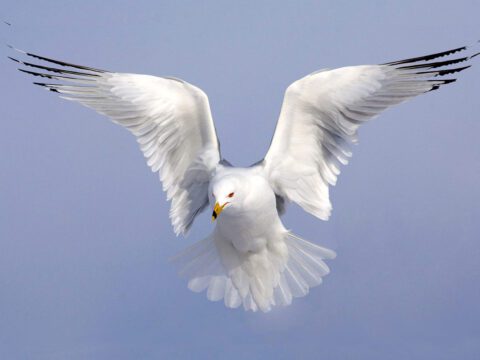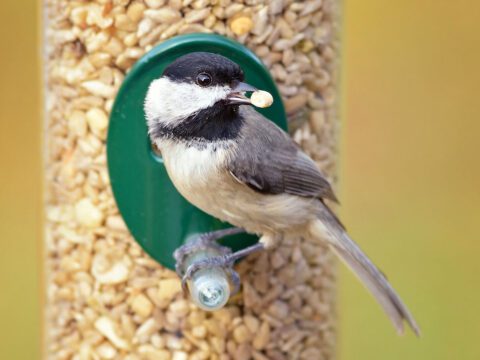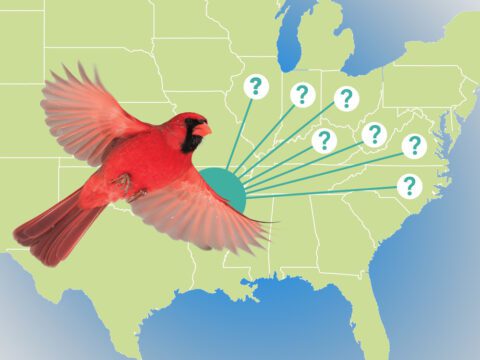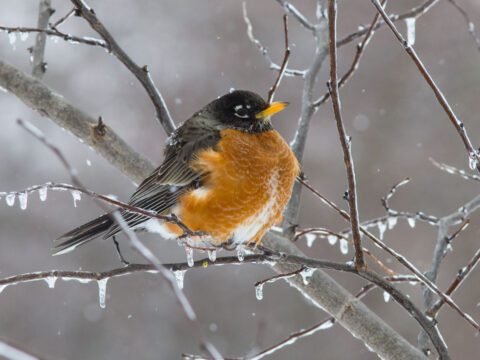AOU Thursday: Hope for Solving Bird Collisions
By Caren Cooper, Cornell Lab researcher
August 14, 2009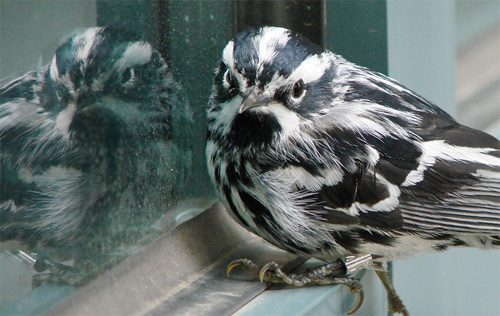
On Thursday afternoon I went to a session titled Anthropogenic Structures, which is how ornithologists refer to birds hitting things that people have built. Millions of birds die each year in collisions with communication towers, windows, and airplanes, but researchers are devising ways to help that are both inventive and practical.
Communication towers
Joelle Gehring of Central Michigan University spoke about the dangers of communications towers. Birds are more likely to hit towers in bad weather and more likely to hit taller towers or towers that have guy wires, she said. But we can’t control the weather and it’s hard to change tower heights or support systems once they’re up. Fortunately, Gehring has discovered that one easy-to-change feature strongly affects collision rates: the lights on the towers.
Through careful experiments, Gehring and her colleagues have learned that simply replacing non-blinking lights with blinking lights can greatly reduce bird mortality. With such a simple and elegant solution, why can’t we change all the lights right now? How many ornithologists does it take to change a light bulb? Assuming that air traffic authorities can determine that we’ll be safe in the air with blinking lights on towers, maybe it won’t be long until this happens. Gehring expects that as soon as the U.S. adopts blinking lights for towers, Canada will soon follow… and then other countries too! The same issues stand for wind-energy turbines, and so you may notice that new wind turbines near you already have blinking lights.
Window strikes
Far and away the most common source of collisions is with windows. Dan Klem, of Muhlenberg College, has worked on this deadly problem for years, and has recently developed windows that birds can see—by exploiting an unusual aspect of birds’ vision. Birds’ eyes have an extra type of color-detecting cell that humans don’t have: it allows them to see in ultraviolet (technically, in the 300-400 nanometer part of the spectrum).
This ability lets kestrels track field mice by following their UV-reflecting urine trails. Male and female Blue Tits in English gardens look the same to us, but to the birds themselves, males have much fancier-looking heads. (Some clever studies have explored these plumage differences by applying UV-blocking sunscreen to feathers.)
Klem reasoned that if he could make a UV-reflecting glass, birds could see and avoid it while people would still get the same great views. The problem is that most window glass is designed to absorb UV, not reflect it. So Klem is working on films or plastic strips (one amusingly called CollidEscape) that can be applied to windows and that make prominent patterns in UV. So far, studies done in wind tunnels show that these special patterns are nearly as good at reducing collisions as glass painted with bright orange stripes.
The scientist involved in that study, Christine Sheppard of the American Bird Conservancy, pointed out that we often regard birds’ inability to see glass as a flaw, but we should remember that people can’t see glass either – that’s why we like it. Sheppard had the audience laughing sympathetically as she showed video from a hidden camera of person after person walking into a very clean pane of glass that looked like the exit to a store. Sheppard pointed out that humans walk into glass and then learn to pay better attention, but when birds hit glass, they die.
Bird-airplane collisions
Pete Marra of the Smithsonian Migratory Bird Center discussed an aspect of bird collisions that gets a lot more public attention: birds that hit airplanes. An estimated 7,400 bird strikes happened in the U.S. in 2007, he said. That’s compared to 30 million take-offs and landings each year, and a total of 229 human deaths and 210 crashed planes from bird strikes since 1988. (Strike numbers are estimated because only the U.S. military is required to report them.)
After Flight 1549 made its famous splashdown in the Hudson River earlier this year (with no injuries to passengers or crew), the Smithsonian Institution’s bird feather identification lab used tissue and feather remains to confirm that Canada Geese took out two of the plane’s engines. It may seem like a question only a birder would ask, but Marra immediately wanted to know whether the geese were migrants or residents—and determined that these geese were migratory, and probably from Greenland.
Knowing the species and its origin (resident or migrant) is essential, Marra said, because they point to very different solutions. If resident species are the problem, we could cull them, modify habitat near airports, or displace them. Migrants are more difficult, but we can at least track the risk by watching their movements on radar.
Marra suggests we push for mandatory reporting of all bird strikes so we can at least see the whole problem. Large-bodied birds such as geese and Turkey Vultures are increasing in numbers, and the problem of bird strikes will only get worse if we don’t collect the data we need to manage the risk.

All About Birds
is a free resource
Available for everyone,
funded by donors like you
American Kestrel by Blair Dudeck / Macaulay Library

